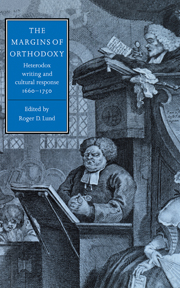Book contents
- Frontmatter
- Contents
- List of contributors
- Acknowledgments
- Introduction
- PART I THE IDEOLOGY AND ORIGINS OF HETERODOXY
- PART II LOCKE AND HETERODOX OPINION
- PART III POLICING THE MARGINS
- 5 Samuel Parker, religious diversity, and the ideology of persecution
- 6 The Societies for the Reformation of Manners: between John Locke and the devil in Augustan England
- 7 Irony as subversion: Thomas Woolston and the crime of wit
- 8 The limits of moderation in a Latitudinarian parson: or, High Church zeal in a low churchman discovere'd
- PART IV ORTHODOX DEFENSES, HETERODOX RESULTS
- Select bibliography
- Index
8 - The limits of moderation in a Latitudinarian parson: or, High Church zeal in a low churchman discovere'd
Published online by Cambridge University Press: 09 October 2009
- Frontmatter
- Contents
- List of contributors
- Acknowledgments
- Introduction
- PART I THE IDEOLOGY AND ORIGINS OF HETERODOXY
- PART II LOCKE AND HETERODOX OPINION
- PART III POLICING THE MARGINS
- 5 Samuel Parker, religious diversity, and the ideology of persecution
- 6 The Societies for the Reformation of Manners: between John Locke and the devil in Augustan England
- 7 Irony as subversion: Thomas Woolston and the crime of wit
- 8 The limits of moderation in a Latitudinarian parson: or, High Church zeal in a low churchman discovere'd
- PART IV ORTHODOX DEFENSES, HETERODOX RESULTS
- Select bibliography
- Index
Summary
In the political and religious turmoil of the late seventeenth and early eighteenth centuries some clergymen began to urge “moderation.” By this they meant comprehension of orthodox Dissenters within the Church of England. Dissenters were persecuted in the Restoration period, and many clergymen felt that this persecution was too extensive and too severe. They proposed to “widen the Terms” under which nonconformists could be comprehended by the church. The proposal for greater latitude within the church by these divines led many others to fear for the purity of the church, and soon reactionaries applied the pejorative “Latitude-Men,” or “Latitudinarians”, to the advocates of a policy of moderation. These “Low Churchmen,” as they were also called, were frequently branded as trimmers who sold their birthright in the Church of England for a mess of pottage. As one of their opponents wrote, “the common Notion of a moderate Minister is … one that will comply with the humours and fancies of all Parties, and oblige them by condescentions of this nature.” They were perceived as traitors to the church who would tolerate or compromise with anything, even deism and atheism. For this reason Henry Sacheverell, after the defeat of the Occasional Conformity Bill, lashed out and called all such Latitude-Men “False Brethren” because they were allowing a pure church to become defiled.
In Sacheverell's time these “Latitude-Men” were also politically linked to the Whig party, a linkage with apparent origins in the debates surrounding the Popish Plot and the Exclusion Crisis.
- Type
- Chapter
- Information
- The Margins of OrthodoxyHeterodox Writing and Cultural Response, 1660–1750, pp. 195 - 216Publisher: Cambridge University PressPrint publication year: 1995



